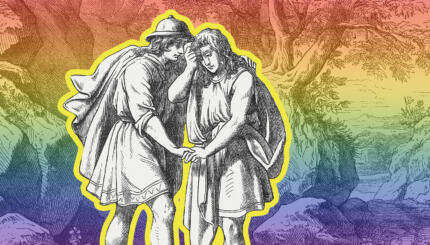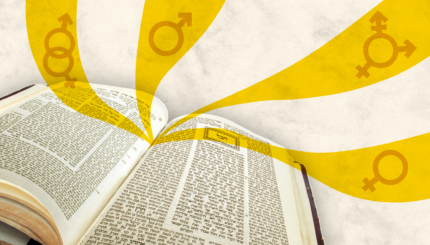Jews read sections of the Torah each week, and these sections, known as parshiyot, inspire endless examination year after year. Each week we will bring you regular essays examining these portions from a queer perspective, drawn from the Torah Queeries online collection, which was inspired by the book Torah Queeries: Weekly Commentaries on the Hebrew Bible. This week, Melissa B. Simon examines Parashat Pinchas and the question of who counts.This D’var Torah is dedicated to the Memory of Wendy Kanter, a true Woman of Valor.
In the summer of 2007, I worked in a large New York City hospital as a chaplain.
Each day we were given, from the central computing office, a long census listing each patient. They were reduced to a name, age, religion, sex and health insurance provider. In black and white on the pages of the list, the people disappear. Gone are their stories, their families and their histories.
To the computer, each patient becomes a number, but it is the chaplain’s job to turn the patient back into a person. We sit at their bedsides, listen as they cry and offer words of strength. “Baby Girl” becomes Maddie, a vivacious infant with deep and wise eyes. Number 24601 is Grace, enmeshed in pain, but thankful to participate in a deep theological discussion.
In
Parashat Pinchas
, the Israelites in the desert conduct a census of the people. A great plague has decimated the Israelites and thirty-nine years after a census was completed in
Parashat Bamidbar
, it is time to recalculate the people. All of the adults over age twenty who went forth from Egypt have died, except for Caleb, son of Jephunneh, and Joshua, son of Nun. A new generation, one that did not know slavery, will enter the promised land.
The Torah text calculates that there are 601,730 Israelites. More specifically, G-D tells Moses and Eleazar, the son of Aaron the priest, in Numbers 26:2 to “Take a census of the whole Israelite community from the age of twenty years up, by their ancestral houses, all Israelites able to bear arms.” Thus the census only counts those who are male, over twenty and able to fight.
There are two reasons for conducting the census this way: one is that the Israelites will soon wage war on the people in the land, specifically the Midianites, and they want to see how prepared they are to fight. Also, once the Israelites conquer the land, they will each be assigned different portions. G-D explains to Moses that the land will be given out by lot. “Among these shall the land be apportioned as shares, according to the listed names: with larger groups increase the share, with smaller groups reduce the share. Each is to be assigned its share according to its enrollment” (Numbers 26:52-54).
What did this allotment look like? Rashi said that the land was divided into twelve sections according to size, reflecting the different populations of the tribes. When the lots were drawn, the sizes—miraculously—corresponded correctly so that each tribe ended up with a portion that met their needs. Nachmanides argued that the land was dived equally in size and then handed out. It was the tribes themselves that then divided up family portions according to size.
To both of these commentators, provisions were made to make sure there was a level of equity within the apportioning of the land.
Five brave women recognize an oversight and bring it to the attention of the leadership. When the land is doled out, a portion is given to each man for his family. However, Zelophachad, a descendant of Manasseh, a son of Joseph died in the wilderness and left no sons. He was not part of Korach’s rebellion and his daughters want to make sure that they receive his share in his name. They implore Moses, Eleazar, the priest, the chieftains, and the whole assembly, “Let not our father’s name be lost to his clan just because he had no son! Give us a holding among our father’s kinsmen!” (27:4).
Moses brings the issue before G-D, the ultimate judge and G-D responds saying “The plea of Zelophehad’s daughters is just: you should give them a hereditary holding among their father’s kinsmen; transfer their father’s share to them” (27:7). The Talmud teaches us in Bava Batra 119b that the daughters of Zelophehad were wise women for they spoke at an opportune moment. The Torah lists the names of the women, Mahlah, Noah, Hoglah, Milcah, and Tirzah, marking them as significant. Often in history, and elsewhere in the Torah, women’s voices are silenced and their names erased. In the book of Genesis, for example, Lot’s wife is not given a name and is merely called “ishto” “his wife.” In Parashat Pinchas, not only are Zelophehad’s brave daughters named, but they are given a voice and empowered to speak their minds.
The Daughters of Zelophehad (illustration from the 1908 Bible and Its Story Taught by One Thousand Picture Lessons)
They create legal change, which will then affect future generations of women. Their self-advocacy is backed by G-D; one cannot think of a higher complement.
The changing of the law of inheritance to include daughters is the last legality that Moses oversees. After viewing the land of Israel from the top of Mount Abarim, Moses hands over the leadership to Joshua. In Numbers 27:16 Moses says “Let G-D, Source of the breath of all flesh, appoint someone over the community who shall go out before them and come in before them, and who shall take them out and bring them in, so that the Eternal’s community may not be like sheep that have no shepherd.” Rashi explains that Moses added “Master of the Universe! You know the soul of each and every individual, You know that no two are alike. Appoint for them a leader who can relate to each and every one of them in accordance with his [their] individual spirit.”
While Parashat Pinchas began with a census that broke down the people into groups and abstract numbers, Rashi’s understanding of the change of leadership suggests that ultimately each Israelite was seen as an individual. Different ideas were respected both by the leadership and by G-D. And on the precipice of entering the land, the Israelites were given a leader who would be both a guide and a source of support.
Too often Queer people are viewed as one monolithic group, without regard for the beauty of our diversity. May we be blessed with leaders who understand our variety and see us as individuals. May we grow closer to a loving G-D who accepts each of us as we are. May we have the courage to speak out for what we believe in and find listening ears. And may we each live to view the Promised Land of equality and freedom.
Moved by this post? Join the conversation through MyJewishLearning’s weekly blogs newsletter.
Torah
Pronunced: TORE-uh, Origin: Hebrew, the Five Books of Moses.


